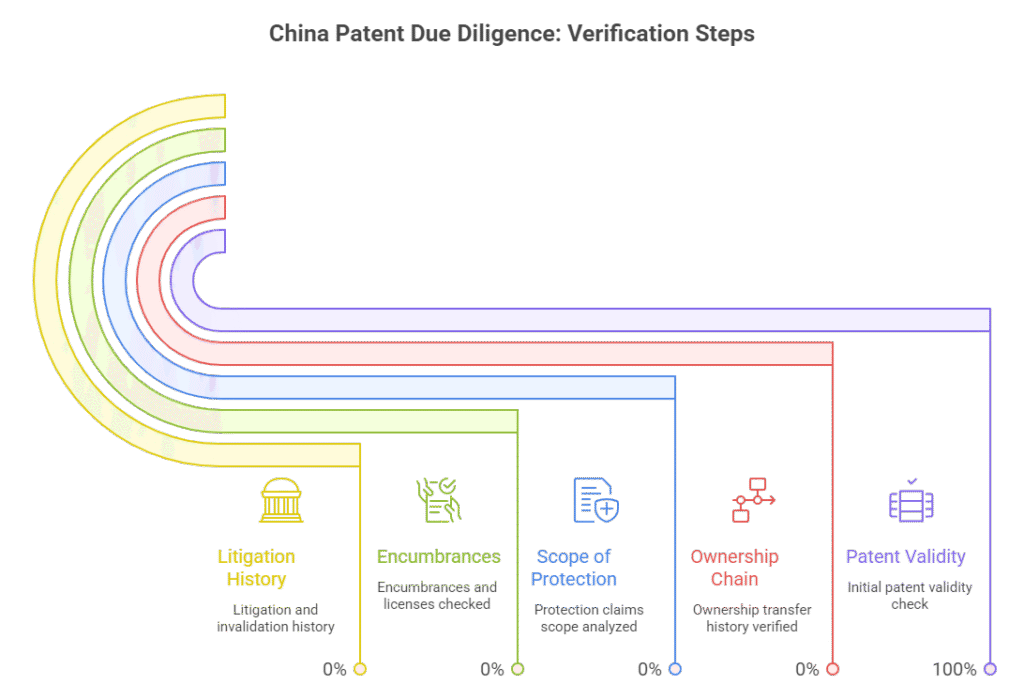Introduction
In China’s innovation-driven economy, patents are critical business assets. For overseas companies partnering with Chinese firms, verifying patent legitimacy prevents costly disputes and ensures secure technology transfers. Yet, fragmented data sources, language barriers, and complex regulations make independent verification challenging. Here’s a streamlined guide to 5 core patent checks.

1. Patent Validity & Maintenance Status
Why it matters: Patents lapse if annual fees are unpaid (Patent Law, Art. 44). Invalid patents offer zero protection.
How to verify:
- Check CNIPA’s (China National Intellectual Property Administration) database for fee payment status.
- Confirm patent type: Invention (20-year term), Utility Model (10 years), or Design (15 years).
Risk if skipped: Acquiring “junk” patents with no legal enforceability.
2. Ownership Chain & Transfer History
Why it matters: Ownership disputes derail M&A deals. Chinese patents require exact entity name matches in transfers (Patent Law, Art. 10).
How to verify:
- Trace assignments via CNIPA’s Patent Register.
- Cross-check business licenses to confirm entity consistency.
Red flag: Gaps between assignment records and the seller’s claimed ownership timeline.
Example: A German automaker discovered a target’s “core patent” was transferred to a shell company 3 months pre-acquisition.
3. Scope of Protection Claims
Why it matters: Overly broad or vague claims invite infringement lawsuits.
How to verify:
- Analyze Claims section in patent documents.
- Validate alignment with products/methods described in the Description.
Tool: Use CNIPA’s bilingual patent search (English/Chinese) for key terms.
4. Encumbrances: Pledges & Licenses
Why it matters: Pledged patents can be seized by creditors; exclusive licenses block usage rights.
How to verify:
- Request Patent Pledge Registration Certificates from sellers.
- Check CNIPA for recorded licensing agreements (Patent Law, Art. 14).
Critical step: Physical inspection of original documents—digital records lag 1–2 months.
5. Litigation & Invalidation History
Why it matters: 15% of Chinese utility patents are invalidated post-grant (CNIPA 2023 data).
How to verify:
- Search China Judgments Online for patent lawsuits.
- Review invalidation decisions via CNIPA’s Reexamination Portal.
Risk hotspot: Design patents—often targeted for invalidation due to similarity claims.
Why DIY Verification Fails
- Language barriers: Legal Chinese ≠ machine-translated English.
- Fragmented data: Court records, CNIPA filings, and local registries aren’t linked.
- Time lags: Encumbrances take weeks to appear in public databases.
Partner with Local Experts
For overseas investors, specialized verification bridges these gaps:
- Bilingual patent attorneys interpret claim scopes.
- Due diligence platforms access real-time encumbrance data.
- On-ground teams physically retrieve non-digitized records.
Example: A U.S. biotech firm avoided licensing an invalidated patent by verifying its status through a comprehensive IP report.
Conclusion
Patent due diligence in China demands legal, technical, and linguistic expertise. Systematic verification of validity, ownership, scope, encumbrances, and litigation history mitigates IP risks. For resource-constrained teams, partnering with China-specialized firms ensures thoroughness and compliance.
